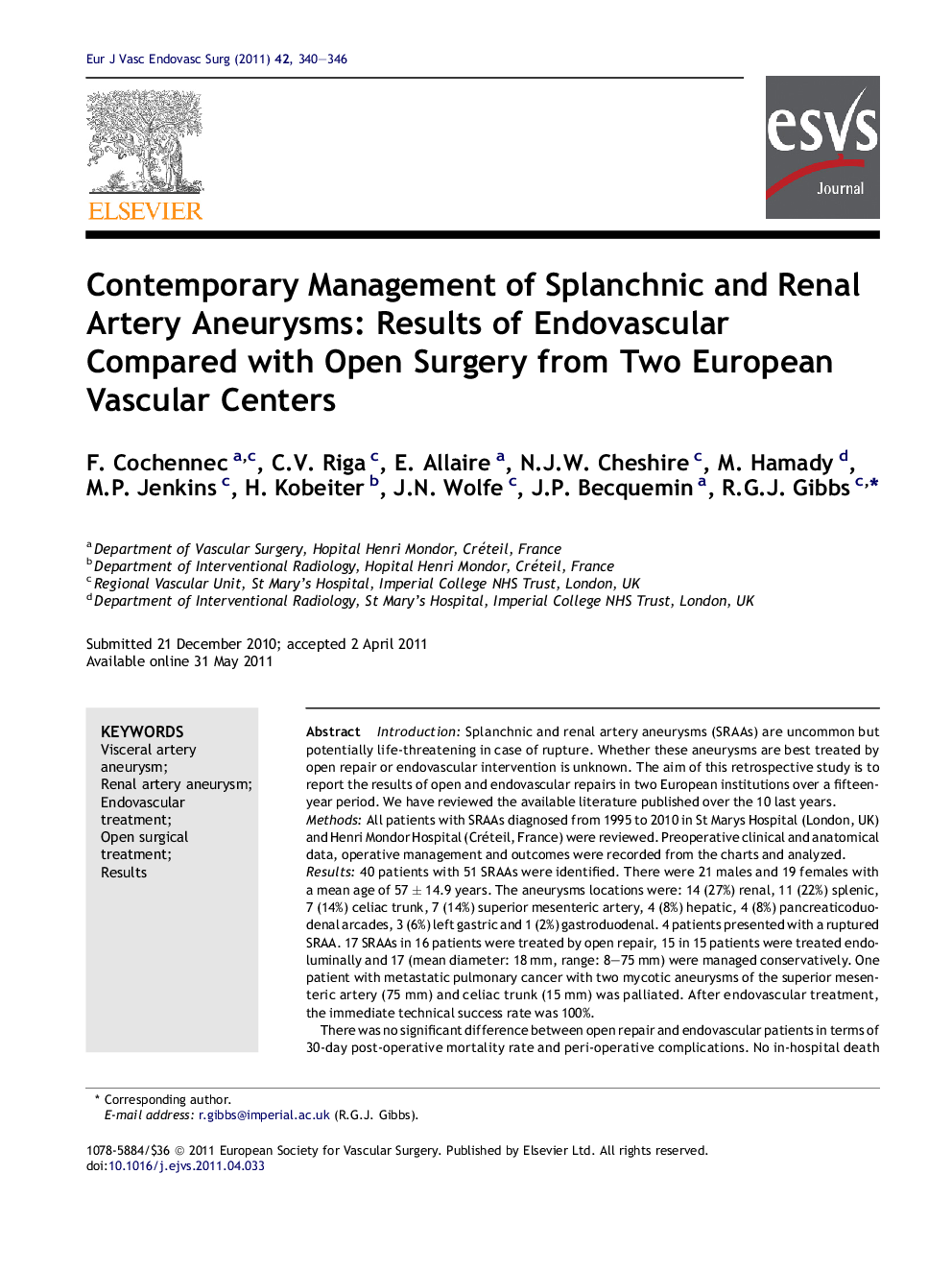| کد مقاله | کد نشریه | سال انتشار | مقاله انگلیسی | نسخه تمام متن |
|---|---|---|---|---|
| 2912271 | 1575486 | 2011 | 7 صفحه PDF | دانلود رایگان |

IntroductionSplanchnic and renal artery aneurysms (SRAAs) are uncommon but potentially life-threatening in case of rupture. Whether these aneurysms are best treated by open repair or endovascular intervention is unknown. The aim of this retrospective study is to report the results of open and endovascular repairs in two European institutions over a fifteen-year period. We have reviewed the available literature published over the 10 last years.MethodsAll patients with SRAAs diagnosed from 1995 to 2010 in St Marys Hospital (London, UK) and Henri Mondor Hospital (Créteil, France) were reviewed. Preoperative clinical and anatomical data, operative management and outcomes were recorded from the charts and analyzed.Results40 patients with 51 SRAAs were identified. There were 21 males and 19 females with a mean age of 57 ± 14.9 years. The aneurysms locations were: 14 (27%) renal, 11 (22%) splenic, 7 (14%) celiac trunk, 7 (14%) superior mesenteric artery, 4 (8%) hepatic, 4 (8%) pancreaticoduodenal arcades, 3 (6%) left gastric and 1 (2%) gastroduodenal. 4 patients presented with a ruptured SRAA. 17 SRAAs in 16 patients were treated by open repair, 15 in 15 patients were treated endoluminally and 17 (mean diameter: 18 mm, range: 8–75 mm) were managed conservatively. One patient with metastatic pulmonary cancer with two mycotic aneurysms of the superior mesenteric artery (75 mm) and celiac trunk (15 mm) was palliated. After endovascular treatment, the immediate technical success rate was 100%.There was no significant difference between open repair and endovascular patients in terms of 30-day post-operative mortality rate and peri-operative complications. No in-hospital death occurred in patients treated electively. Postoperatively, four patients (1 ruptured and 3 elective) suffered non-lethal mild to severe complication in the open repair group, as compared with one in the endovascular group (p = .34). The mean length of stay was significantly higher after open repair as compared with endovascular repair (17 days, range: 8–56 days vs. 4 days, range: 2–6; p < .001).The mean follow-up time was 17.8 months (range: 0–143 months) after open repair, 15.8 months (range: 0–121 months) after endovascular treatment, and 24.8 (range: 3–64 months) for patient being managed conservatively. No late death related to the VAA occurred. In each group, 2 successful reoperations were deemed necessary. In the endovascular group, two patients presented a reperfusion of the aneurysmal sac at 6 and 24 months respectively.ConclusionNo significant difference in term of 30-day mortality and post-operative complication rates could be identified between open repair and endovascular treatment in the present series. Endovascular treatment is a safe alternative to open repair but patients are exposed to the risk of aneurysmal reperfusion. This mandates careful long-term imaging follow up in patients treated endoluminally.
Journal: European Journal of Vascular and Endovascular Surgery - Volume 42, Issue 3, September 2011, Pages 340–346